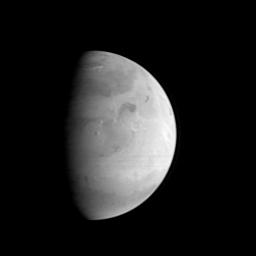
|
MGS Approach Image - Elysium Region
- Click the image above for a larger view
- Full-Res JPEG (512 x 512) (9.5 kB)
- Full-Res TIFF (512 x 512) (54.8 kB)
Caption:
This Mars Orbiter Camera (MOC) picture shows the Elysium region of Mars as it appeared from the Mars Global Surveyor (MGS) spacecraft on August 20, 1997. At the time, MGS was 5.57 million kilometers (3.46 million miles) and 22 days from Mars, and the picture has a resolution is about 20.8 km per picture element. Mars, 6800 km (4200 mile) in diameter, is about 327 pixels across. North is at the top of the image. The camera was pointed at the center of the planet (near the dark, morning sunrise line, or terminator) at 23.6° N, 217.4° W. At this distance from Mars, only atmospheric phenomena (clouds and fogs) and bright and dark markings resulting from variations in the amount and thickness of dust and sand are usually visible. However, in this view the shading of the relief of the three Elysium volcanoes (from north to south Hector Tholus, Elysium Mons, and Albor Tholus) can be seen owing to their position close to the terminator. Elysium Mons, the center-most volcano, is estimated to be 12,000-14,000 meters (39,000 to 46,000 feet) high.
Mars Global Surveyor has been enroute to Mars since November 7, 1996 and arrives there on Thursday, September 11 around 6:30 PM PDT. The spacecraft will use atmospheric drag to reduce the size of its orbit, and will begin mapping operations in March 1998.
Background Info:
Malin Space Science Systems and the California Institute of Technology were responsible for development of the Mars Observer and Mars Global Surveyor cameras. MSSS operates the MOC from its facilities in San Diego, CA, under contract to the Jet Propulsion Laboratory.
Cataloging Keywords:
| Name | Value | Additional Values |
|---|---|---|
| Target | Mars | |
| System | ||
| Target Type | Planet | |
| Mission | Mars Global Surveyor (MGS) | |
| Instrument Host | Mars Global Surveyor | |
| Host Type | Orbiter | |
| Instrument | Mars Orbiter Camera (MOC) | |
| Detector | ||
| Extra Keywords | Atmosphere, Dust, Grayscale, Mountain, Volcano | |
| Acquisition Date | ||
| Release Date | 1997-08-22 | |
| Date in Caption | 1996-11-07 | 1997-08-20 |
| Image Credit | NASA/JPL/Malin Space Science Systems | |
| Source | photojournal.jpl.nasa.gov/catalog/PIA00912 | |
| Identifier | PIA00912 | |
